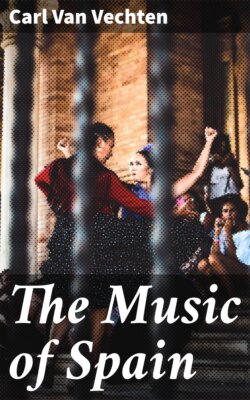Читать книгу The Music of Spain - Carl Van Vechten - Страница 6
На сайте Литреса книга снята с продажи.
III
ОглавлениеTable of Contents
All the world dances in Spain, at least it would seem so, in reading over the books of the Marco Polos who have made voyages of discovery on the Iberian peninsula. Guitars seem to be as common there as pea-shooters in New England, and strumming seems to set the feet a-tapping and voices a-singing, what, they care not. (Havelock Ellis says: "It is not always agreeable to the Spaniard to find that dancing is regarded by the foreigner as a peculiar and important Spanish institution. Even Valera, with his wide culture, could not escape this feeling; in a review of a book about Spain by an American author entitled 'The Land of the Castanet'—a book which he recognized as full of appreciation for Spain—Valera resented the title. It is, he says, as though a book about the United States should be called 'The Land of Bacon.'") Oriental colour is streaked through and through the melodies and harmonies, many of which betray their Arabian origin; others are flamenco, or gipsy. The dances, almost invariably accompanied by song, are generally in 3-4 time or its variants such as 6-8 or 3-8; the tango, of course, is in 2-4. But the dancers evolve the most elaborate inter-rhythms out of these simple measures, creating thereby a complexity of effect which defies any comprehensible notation on paper. As it is on this fioritura, if I may be permitted to use the word in this connection, of the dancer that the sophisticated composer bases some of his most natural and national effects, I shall linger on the subject. La Argentina has re-arranged many of the Spanish dances for purposes of the concert stage, but in her translation she has retained in a large measure this interesting complication of rhythm, marking the irregularity of the beat, now with a singularly complicated detonation of heel-tapping, now with a sudden bend of a knee, now with the subtle quiver of an eyelash, now with a shower of castanet sparks (an instrument which requires a hard tutelage for its complete mastery; Richard Ford tells us that even the children in the streets of Spain rap shells together, to become self-taught artists in the use of it). Chabrier, in his visit to Spain with his wife in 1882, attempted to note down some of these rhythmic variations achieved by the dancers while the musicians strummed their guitars, and he was partially successful. But all in all he only succeeded in giving in a single measure each variation; he did not attempt to weave them into the intricate pattern which the Spanish women contrive to make of them.
